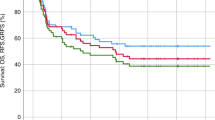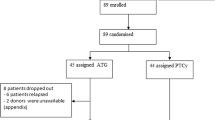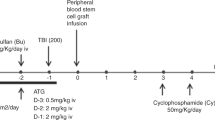Abstract
Antithymocyte globulin (ATG)-based immunosuppression remains the standard immunosuppressive therapy (IST) for aplastic anemia (AA) patients lacking a sibling donor; however, treatment failures are relatively frequent, including about one-quarter to one-third of patients who do not show any response to initial IST, and about half of the initial responders who may experience subsequent relapses or require continuous maintenance IST. For these patients, there is the option of further IST, which may include additional courses of ATG-based IST, or attempts with alternative IST regimens. Alemtuzumab is a monoclonal anti-CD52 Ab, which has been recently investigated as novel IS agent for the treatment of AA patients. Recent data from different groups have clearly demonstrated the biological efficacy of Alemtuzumab in AA patients, ruling out the initial concerns about possible unacceptable infectious risks secondary to its extremely powerful lympholytic effect. Preliminary data demonstrate a remarkable efficacy, especially in the context of relapsed and, to less extent, refractory patients, whereas data in naïve patients are still limited. On the basis of these results, Alemtuzumab-based immunosuppression is a worthy option for AA and other marrow failure patients requiring a second-line IST. Here we describe a consensus regimen that the European Group for Blood and Marrow Transplantation Severe Aplastic Anemia Working Party suggests for AA patients failing initial IST who are not indicated for SCT.
This is a preview of subscription content, access via your institution
Access options
Subscribe to this journal
Receive 12 print issues and online access
$259.00 per year
only $21.58 per issue
Buy this article
- Purchase on Springer Link
- Instant access to full article PDF
Prices may be subject to local taxes which are calculated during checkout
Similar content being viewed by others
References
Young NS . Acquired aplastic anemia. In: Young NS (ed.). Bone Marrow Failure Syndromes. WB Saunders: Philadelphia, 2000, pp 1–46.
Young NS, Maciejewski J . The pathophysiology of acquired aplastic anemia. N Engl J Med 1997; 336: 1365–1372.
Young NS, Calado RT, Scheinberg P . Current concepts in the pathophysiology and treatment of aplastic anemia. Blood 2006; 108: 2509–2519.
Risitano AM, Maciejewski JP, Green S, Plasilova M, Zeng W, Young NS . In vivo dominant immune responses in aplastic anaemia: molecular tracking of putatively pathogenetic T-cell clones by TCR beta-CDR3 sequencing. Lancet 2004; 364: 355–364.
Marsh JC, Ball SE, Cavenagh J, Darbyshire P, Dokal I, Gordon-Smith EC et al. Guidelines for the diagnosis and management of aplastic anaemia. Br J Haematol 2009; 147: 43–70.
Risitano AM . Immunosuppressive therapies in the management of immune-mediated marrow failures in adults: where we stand and where we are going. Br J Haematol 2011; 152: 127–140.
Frickhofen N, Kaltwasser JP, Schrezenmeier H, Raghavachar A, Vogt HG, Herrmann F et al. Treatment of aplastic anemia with antilymphocyte globulin and methylprednisolone with or without cyclosporine. The German Aplastic Anemia Study Group. N Engl J Med 1991; 324: 1297–1304.
Frickhofen N, Heimpel H, Kaltwasser JP, Schrezenmeier H, German Aplastic Anemia Study Group. Antithymocyte globulin with or without cyclosporin A: 11-year follow-up of a randomized trial comparing treatments of aplastic anemia. Blood 2003; 101: 1236–1242.
Marsh J . Making therapeutic decisions in adults with aplastic anemia. Hematol Am Soc Hematol Educ Program 2006, 78–85.
Bacigalupo A . Aplastic anemia: pathogenesis and treatment. Hematol Am Soc Hematol Educ Program 2007, 23–28.
Rosenfeld SJ, Kimball J, Vining D, Young NS . Intensive immunosuppression with antithymocyte globulin and cyclosporine as treatment for severe acquired aplastic anemia. Blood 1995; 85: 3058–3065.
Rosenfeld S, Follmann D, Nunez O, Young NS . Antithymocyte globulin and cyclosporine for severe aplastic anemia: association between hematologic response and long-term outcome. J Am Med Assoc 2003; 289: 1130–1135.
Locasciulli A, Oneto R, Bacigalupo A, Socié G, Korthof E, Bekassy A et al. Severe Aplastic Anemia Working Party of the European Blood and Marrow Transplant Group. Outcome of patients with acquired aplastic anemia given first line bone marrow transplantation or immunosuppressive treatment in the last decade: a report from the European Group for Blood and Marrow Transplantation (EBMT). Haematologica 2007; 92: 11–18.
Bacigalupo A, Bruno B, Saracco P, Di Bona E, Locasciulli A, Locatelli F et al. Antilymphocyte globulin, cyclosporine, prednisolone, and granulocyte colony-stimulating factor for severe aplastic anemia: an update of the GITMO/EBMT study on 100 patients. European Group for Blood and Marrow Transplantation (EBMT) Working Party on Severe Aplastic Anemia and the Gruppo Italiano Trapianti di Midolio Osseo (GITMO). Blood 2000; 95: 1931–1934.
Teramura M, Kimura A, Iwase S, Yonemura Y, Nakao S, Urabe A et al. Treatment of severe aplastic anemia with antithymocyte globulin and cyclosporin A with or without G-CSF in adults: a multicenter randomized study in Japan. Blood 2007; 110: 1756–1761.
Scheinberg P, Nunez O, Weinstein BP, Scheinberg P, Biancotto A, Wu CO et al. Horse versus rabbit antithymocyte globulin in acquired aplastic anemia. N Engl J Med 2011; 365: 430–438.
Marsh J, Bacigalupo A, Schrezenmeier H, Tichelli A, Risitano AM, Passweg JR et al. Prospective study of rabbit antithymocyte globulin and cyclosporine for aplastic anemia from the EBMT Severe Aplastic Anaemia Working Party. Blood 2012; 119: 5391–5396.
Scheinberg P, Wu CO, Nunez O, Young NS . Predicting response to immunosuppressive therapy and survival in severe aplastic anaemia. Br J Haematol 2009; 144: 206–216.
Scheinberg P, Wu CO, Nunez O, Scheinberg P, Boss C, Sloand EM et al. Treatment of severe aplastic anemia with a combination of horse antithymocyte globulin and cyclosporine, with or without sirolimus: a prospective randomized study. Haematologica 2009; 94: 348–354.
Tichelli A, Schrezenmeier H, Socie G, Marsh J, Bacigalupo A, Duhrsen U et al. A randomized controlled study in newly-diagnosed severe aplastic anemia patients receiving antithymocyte globulin, ciclosporin, with or without G-CSF. Blood 2011; 117: 4434–4441.
Maciejewski JP, Risitano A, Sloand EM, Nunez O, Young NS . Distinct clinical outcomes for cytogenetic abnormalities evolving from aplastic anemia. Blood 2002; 99: 3129–3135.
Tichelli A, Passweg J, Nissen C, Bargetzi M, Hoffmann T, Wodnar-Filipowicz A et al. Repeated treatment with horse antilymphocyte globulin for severe aplastic anaemia. Br J Haematol 1998; 100: 393–400.
Di Bona E, Rodeghiero F, Bruno B, Gabbas A, Foa P, Locasciulli A et al. Rabbit antithymocyte globulin (r-ATG) plus cyclosporine and granulocyte colony stimulating factor is an effective treatment for aplastic anaemia patients unresponsive to a first course of intensive immunosuppressive therapy. Gruppo Italiano Trapianto di Midollo Osseo (GITMO). Br J Haematol 1999; 107: 330–334.
Scheinberg P, Nunez O, Young NS . Re-treatment with rabbit antithymocyte globulin and ciclosporin for patients with relapsed or refractory severe aplastic anaemia. Br J Haematol 2006; 133: 622–627.
Schrezenmeier H, Marin P, Raghavachar A, McCann S, Hows J, Gluckman E et al. Relapse of aplastic anaemia after immunosuppressive treatment: a report from the European Bone Marrow Transplantation Group SAA Working Party. Br J Haematol 1993; 85: 371–377.
Scheinberg P, Nunez O, Wu C, Young NS . Treatment of severe aplastic anaemia with combined immunosuppression: antithymocyte globulin, ciclosporin and mycophenolate mofetil. Br J Haematol 2006; 133: 606–611.
Brodsky RA, Sensenbrenner LL, Jones RJ . Complete remission in severe aplastic anemia after high-dose cyclophosphamide without bone marrow transplantation. Blood 1996; 87: 491–494.
Tisdale JF, Dunn DE, Geller N, Plante M, Nunez O, Dunbar CE et al. High-dose cyclophosphamide in severe aplastic anaemia: a randomised trial. Lancet 2000; 356: 1554–1559.
Tisdale JF, Maciejewski JP, Nunez O, Rosenfeld SJ, Young NS . Late complications following treatment for severe aplastic anemia (SAA) with high-dose cyclophosphamide (Cy): follow-up of a randomized trial. Blood 2002; 100: 4668–4670.
Brodsky RA, Chen AR, Dorr D, Fuchs EJ, Huff CA, Luznik L et al. High-dose cyclophosphamide for severe aplastic anemia: long-term follow-up. Blood 2010; 115: 2136–2141.
Dumont FJ . Alemtuzumab (Millennium/ILEX). Curr Opin Invest Drugs 2001; 2: 139–160.
Mohan SR, Clemente MJ, Afable M, Cazzolli HN, Bejanyan N, Wlodarski MW et al. Therapeutic implications of variable expression of CD52 on clonal cytotoxic T cells in CD8+ large granular lymphocyte leukemia. Haematologica 2009; 94: 1407–1414.
CAMMS223 Trial Investigators, Coles AJ, Compston DA, Selmaj KW, Lake SL, Moran S, Margolin DH et al. Alemtuzumab vs interferon beta-1a in early multiple sclerosis. N Engl J Med 2008; 359: 1786–1801.
Kottaridis PD, Milligan DW, Chopra R, Chakraverty RK, Chakrabarti S, Robinson S et al. In vivo Campath-1H prevents graft-versus-host disease following non myeloablative stem cell transplantation. Blood 2000; 96: 2419–2425.
Chakraverty R, Peggs K, Chopra R, Milligan DW, Kottaridis PD, Verfuerth S et al. Limiting transplantation-related mortality following unrelated donor stem cell transplantation by using a nonmyeloablative conditioning regimen. Blood 2002; 99: 1071–1078.
Marsh JC, Gupta V, Lim Z, Ho AY, Ireland RM, Hayden J et al. Alemtuzumab with fludarabine and cyclophosphamide reduces chronic graft-versus-host disease after allogeneic stem cell transplantation for acquired aplastic anemia. Blood 2011; 118: 2351–2357.
Morris EC, Rebello P, Thomson KJ, Peggs KS, Kyriakou C, Goldstone AH et al. Pharmacokinetics of alemtuzumab used for in vivo and in vitro T-cell depletion in allogeneic transplantation: relevance for early adoptive immunotherapy and infectious complications. Blood 2003; 102: 404–406.
Hale G, Rebello P, Brettman LR, Fegan C, Kennedy B, Kimby E et al. Blood concentrations of alemtuzumab and antiglobulins responses in patients with chronic lymphocytic leukemia following intravenous or subcutaneous route of administration. Blood 2004; 104: 948–955.
Risitano AM, Selleri C, Serio B, Torelli GF, Kulagin A, Maury S et al. Working Party Severe Aplastic Anaemia (WPSAA) of the European Group for Blood and Marrow Transplantation (EBMT). Alemtuzumab is safe and effective as immunosuppressive treatment for aplastic anaemia and single-lineage marrow failure: a pilot study and a survey from the EBMT WPSAA. Br J Haematol 2010; 148: 791–796.
Willis F, Marsh JCW, Bevan DH, Killick SB, Lucas G, Griffiths R et al. The effect of treatment with Campath-1H in patients with autoimmune cytopenias. Br J Haematol 2001; 114: 891–898.
Risitano AM, Serio B, Selleri C, Rotoli B . Valganciclovir as CMV reactivation prophylaxis in patients receiving alemtuzumab for marrow failure syndromes. Ann Hematol 2009; 88: 1261–1262.
Marotta S, Selleri C, Serio B, Raia M, Del Vecchio L, De Palma R et al. Long-term follow up of a pilot study with alemtuzumab and low-dose cyclosporine A for aplastic anemia and single-lineage marrow failures. Bone Marrow Transplant 2012; 47 (Suppl 1): 223.
Gibbs SD, Westerman DA, McCormack C, Seymour JF, Miles Prince H . Severe and prolonged myeloid haematopoietic toxicity with myelodysplastic features following alemtuzumab therapy in patients with peripheral T-cell lymphoproliferative disorders. Br J Haematol 2005; 130: 87–91.
Hertenstein B, Wagner B, Bunjes D, Duncker C, Raghavachar A, Arnold R et al. Emergence of CD52−, phosphatidylinositolglycan-anchor-deficient T lymphocytes after in vivo application of Campath-1H for refractory B-cell non-Hodgkin lymphoma. Blood 1995; 86: 1487–1492.
Taylor VC, Sims M, Brett S, Field MC . Antibody selection against CD52 produces a paroxysmal nocturnal haemoglobinuria phenotype in human lymphocytes by a novel mechanism. Biochem J 1997; 322: 919–925.
Rawstron AC, Rollinson SJ, Richards S, Short MA, English A, Morgan GJ et al. The PNH phenotype cells that emerge in most patients after CAMPATH-1H therapy are present prior to treatment. Br J Haematol 1999; 107: 148–153.
Scheinberg P, Nunez O, Weinstein B, Scheinberg P, Wu CO, Young NS . Activity of alemtuzumab monotherapy in treatment-naive, relapsed, and refractory severe acquired aplastic anemia. Blood 2012; 119: 345–354.
Scheinberg P, Fischer SH, Li L, Wu CO, Sloand EM, Cohen JI et al. Distinct EBV and CMV reactivation patterns following antibody-based immunosuppressive regimens in patients with severe aplastic anemia. Blood 2007; 109: 3219–3224.
Kim H, Min YJ, Baek JH, Shin SJ, Lee EH, Noh EK et al. A pilot dose-escalating study of alemtuzumab plus cyclosporine for patients with bone marrow failure syndrome. Leuk Res 2009; 33: 222–231.
Gómez-Almaguer D, Jaime-Pérez JC, Garza-Rodríguez V, Chapa-Rodríguez A, Tarín-Arzaga L, Herrera-Garza JL et al. Subcutaneous alemtuzumab plus cyclosporine for the treatment of aplastic anemia. Ann Hematol 2010; 89: 299–303.
Sawada K, Fujishima N, Hirokawa M . Acquired pure red cell aplasia: updated review of treatment. Br J Haematol 2008; 142: 505–514.
Au WY, Lam CC, Chim CS, Pang AW, Kwong YL . Alemtuzumab induced complete remission of therapy-resistant pure red cell aplasia. Leuk Res 2005; 29: 1213–1215.
Ru X, Liebman HA . Successful treatment of refractory pure red cell aplasia associated with lymphoproliferative disorders with the anti-CD52 monoclonal antibody alemtuzumab (Campath-1H). Br J Haematol 2003; 123: 278–281.
Author information
Authors and Affiliations
Corresponding author
Ethics declarations
Competing interests
The authors declare no conflict of interest.
Rights and permissions
About this article
Cite this article
Risitano, A., Schrezenmeier, H. Alternative immunosuppression in patients failing immunosuppression with ATG who are not transplant candidates: Campath (Alemtuzumab). Bone Marrow Transplant 48, 186–190 (2013). https://doi.org/10.1038/bmt.2012.245
Received:
Accepted:
Published:
Issue Date:
DOI: https://doi.org/10.1038/bmt.2012.245
Keywords
This article is cited by
-
Use of eltrombopag in aplastic anemia in Europe
Annals of Hematology (2019)
-
Aplastische Anämie
Der Internist (2015)



